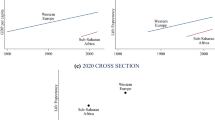Abstract
The UNESCO World Heritage List is designed to protect the global heritage. We show that, with respect to countries and continents, the existing World Heritage List is highly imbalanced. Major econometric determinants of this imbalance are historical GDP, historical population, area in square kilometers of a country, and number of years of high civilization. Surprisingly, economic and political factors, such as membership on the UN Security Council, which should be unrelated to the value of a country’s heritage and therefore should have no impact, are shown to have a systematic impact on the composition of the World Heritage List.

Similar content being viewed by others
Notes
After the 36th ordinary session of the World Heritage Committee, held in Saint Petersburg on June 24, 2012–July 6, 2012. Only two Sites have been de-listed since the implementation of the List. http://whc.unesco.org/en/list, accessed on January 29, 2013.
http://www.economist.com/node/18119225?story_id=18119225, accessed on February 20, 2011.
These are Mesopotamian, Arabian, Phoenician, Persian, Egyptian, Ottoman, Jewish, Greek, Occident, Aegean, Roman, Byzantine, Indian, Chinese, Mongolian, and Japanese.
Testing Cultural and Natural Sites separately, the coefficient for Natural Sites in contrast is statistically not significant, as expected, which supports our approach to use this variable as a proxy for cultural potential.
As expected, the impact of historical GDP per capita is stronger for Cultural Sites. It has no significant impact on the number of Natural Sites.
Again, as expected, the historical size of the population has no significant effect on the number of Natural Sites.
This variable is sometimes also used as a measure for tourist specialization Arezki et al. (2009). Tourism Specialization and Economic Development: Evidence from the UNESCO World Heritage List. IMF Working Paper.
As an alternative measure, we also tested the total number of tourists: this variable has a positive and significant impact. However, if accounting for the size of the population by taking the share of tourists divided by the total population, the impact becomes statistically insignificant (not shown in Table 2).
The results are not shown here, but available from the authors.
References
Arezki R, Cherif R, Piotrowski J (2009) Tourism specialization and economic development: evidence from the UNESCO world heritage list. IMF Working Paper
Ashworth GJ, van der Aa BJM (2006) Strategy and policy for the world heritage convention: goals, practices and future solutions. In: Leask A, Fyall A (eds) Managing world heritage sites. Elsevier, London
Beck T, Clarke G, Groff A, Keefer P, Walsh P (2001) New tools in comparative political economy: the database of political institutions. World Bank Econ Rev 15:165–176
Bertacchini EE, Saccone D (2012) Toward a political economy of world heritage. J Cult Econ 36:327–352
Bertacchini E, Saccone D, Santagata W (2011) Loving diversity, correcting inequalities: towards a new global governance for the UNESCO world heritage. Int J Cult Policy (Forthcoming)
Buchanan JM (1980) Rent seeking and profit seeking. In: Buchanan JM, Tollison RM, Tullock G (eds) Toward a theory of the rent-seeking society. Texas A&M University Press, Texas
Cleere H (2006) Foreword. In: Leask AFA (ed) Managing world heritage sites. Elsevier, London
Debenham F (1984) Reader’s digest world atlas. Das Beste G.M.B.H, Stuttgart
Dreher A, Sturm J-E, Vreeland JR (2009) Development aid and international politics: does membership on the UN Security council influence World Bank decisions? J Dev Econ 88:1–18
Frey BS, Pamini P (2010) World heritage: where are we? An empirical analysis. CESifo Working Paper Series. IFO, Munich
Frey BS, Steiner L (2011) World heritage list: does it make sense? Int J Cul Policy (forthcoming)
Harrison D, Hitchcock M (2005) The politics of heritage. Negotiating tourism and conservation Channel view. Channel View Publications, Clevedon
Henley J (2001) Fighting for the mighty monuments. Guardian Unlimited
Johnson P, Thomas B (1995) Heritage as business. In: Herbert DT (ed) Heritage, tourism and society. Mansell Publishing, New York
Leask A, Fyall A (2006) Managing world heritage sites. Elsevier, Amsterdam
Maddison A (2007) Contours of the world economy 1–2030 AD: essays in macro-economic history. Oxford University Press, Oxford
Musitelli J (2002) World heritage, between universalism and globalization. Int J Cult Prop 11:323–336
O’Brien P (2007) Concise atlas of world history. Oxford University Press, New York
Olmland A (1997) World heritage—and the relationship between the global and the local. Department of Archaeology, University of Cambridge, Cambridge
Peacock A, Rizzo I (2008) The heritage game. Economics, politics and practice. Oxford University Press, Oxford
Pressouyre L (1996) The world heritage convention twenty years later. UNESCO Publishing, Paris
Rizzo I, Towse R (2002) The economics of heritage. Edward Elgar, Cheltenham
Shackley M (2006) Visitor management: case studies from world heritage sites. Butterworth-Heinemann, Oxford
Steiner L, Frey BS (2012) Correcting the imbalance of the world heritage list: did the UNESCO strategy work? J Int Organ Stud 3:25–40
Strasser P (2002) “Putting reform into action”—thirty years of the world heritage convention: how to reform a convention without changing its regulations. Int J Cult Prop 11:215–266
UNESCO (2005) Operational guidelines for the implementation of the world heritage convention. http://whc.unesco.org/archive/opguide05-en.pdf
Van der Aa BJM (2005) Preserving the heritage of humanity? Obtaining world heritage status and the impacts of listing. Netherlands Organization for Scientific Research, Amsterdam
Yang C-H, Lin H-L, Han C–C (2009) Analysis of international tourist arrivals in China: the role of world heritage sites. Tour Manag 31:827–837
Acknowledgments
For helpful suggestions, we are indebted to Trine Bille, Reto Cueni, Axel Dreher, Peter Egger, Christoph Engel, Walter Santagata, Jan-Egbert Sturm, David Throsby, and James Vreeland. We thank the participants of the PEIO conference 2011 and of the ACEI conference 2011, where an earlier version was presented. Further, we are thankful to Maurizio Galli for the support provided in the data handling.
Author information
Authors and Affiliations
Corresponding author
Rights and permissions
About this article
Cite this article
Frey, B.S., Pamini, P. & Steiner, L. Explaining the World Heritage List: an empirical study. Int Rev Econ 60, 1–19 (2013). https://doi.org/10.1007/s12232-013-0174-4
Received:
Accepted:
Published:
Issue Date:
DOI: https://doi.org/10.1007/s12232-013-0174-4




